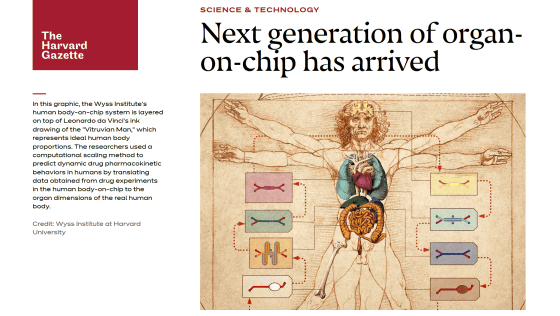Progress in 'research to reproduce human organs on a chip', speeding up drug development and reducing animal experiments

In modern drug and cosmetic development, animal experiments are required as a pre-stage for human clinical trials. Acquiring accurate results in animal experiments not only takes time and cost, but ethical issues have also been pointed out, but in recent years ' research on reproducing human organs on a memory stick size chip ' has advanced. However, it may be useful for speeding up drug development and reducing animal experiments.
Robotic fluidic coupling and interrogation of multiple vascularized organ chips | Nature Biomedical Engineering
Quantitative prediction of human pharmacokinetic responses to drugs via fluidically coupled vascularized organ chips | Nature Biomedical Engineering
https://www.nature.com/articles/s41551-019-0498-9
Human body-on-chip platform may speed up drug development – Harvard Gazette
https://news.harvard.edu/gazette/story/2020/01/human-body-on-chip-platform-may-speed-up-drug-development/

Human body-on-chip could overcome current limitations of drug testing
It is said that it is necessary to break through several barriers before a single drug is developed and hit the market, and it is not uncommon to spend R & D costs of 10 years or more and tens of billions of yen. It is also estimated that only 13.8% of the drugs tested will actually be approved and delivered to the clinic. Human clinical trials are required at the final stage of development, and in the process, experiments are being conducted on cultured cells and animals.
Experiments using cultured human cells are relatively low cost, but experiments are performed under conditions that are far from the environment in the living body, and in some cases cells have lost their original functions. Also, in experiments targeting animals, it is possible to evaluate the process in which the drug travels throughout the body, but it is difficult to reproduce the exact same conditions as in the human body due to the difference in species, and the effectiveness of substances that are drug candidates It is said that it is difficult to grasp the safety and safety accurately. For example, side effects that did not appear in monkeys of real animals appeared in humans, or side effects that did not appear in humans appeared in the monkey experimental stage, so there is a possibility that the development of promising drugs may stop at the animal experiment stage is.

As a technology that overcomes these drug development bottlenecks, attention is focused on the development of an 'organ chip' that reproduces the physiological functions of human organs on a chip. In 2010, Dr.
The organ chip is the size of a computer memory stick, and is a microfluidic culture device composed of a transparent and flexible polymer . The chip consists of two channels separated by a porous membrane.One organ channel imitates the culture of specific organ cells and the other channel imitates the vascular system of vascular endothelial cells. Is said to have been cultured. Independent fluids are sent to the two channels to maintain the function as an organ model, but it is possible to exchange molecules such as cytokines , administered drugs, and metabolites that decomposed drugs through the membrane separating the channels.
The research team has already succeeded in developing organ chips such as intestine, liver, kidney, heart, lung, skin, blood-brain barrier , and brain. In a new study, by connecting the vasculature channels of each organ chip, we created an organ chip model that imitates not only individual organs but the whole human body, and how multiple organs are treated when drugs are administered. It seems that it has become possible to analyze whether it reacts to.

by Wyss Institute at Harvard University
Researchers by creating a model by connecting a plurality of organs chips, drug how absorbed upon administration of a drug to a living body, examining points such or to reach at any time in the target site
The research team conducted multiple experiments to evaluate a model in which multiple organ chips were connected. In the first study, we delivered a highly optimized blood substitute with eight organ chips connected. The device seems to have been able to sustain all tissues and organ functions for 3 weeks, and was able to quantitatively predict the amount of chemical substances in each tissue.
In the second study, we built a model in which the organ chips of the intestine, liver, and kidney linked to each other were connected to the fluid mixing reservoir, and blood and drugs could be exchanged between the organ chips in the same way as a living body. He then administered nicotine from an organ chip that mimics the intestine, simulating oral ingestion of chewing gum containing nicotine, where nicotine is absorbed in the intestine, metabolized by the liver, and finally excreted by the kidneys. When the research team analyzed nicotine uptake and metabolism in the model and compared it with the data obtained from real humans, factors such as the maximum nicotine concentration and the time until nicotine reaches each tissue are real human beings. It was confirmed that it strictly reflected the data confirmed in.

by Wyss Institute at Harvard University
The research team is also measuring the pharmacological effect of cisplatin , which is administered as an anticancer drug, using a model that combines multiple organ chips. 'We want to make science fiction a science fact at Wies Labs. We also show that we can use biochips to achieve this level of biomimicry,' said Ingvar. We hope that we will be more interested and gradually reduce the amount of animal testing. ”
Related Posts:
in Science, Posted by log1h_ik







